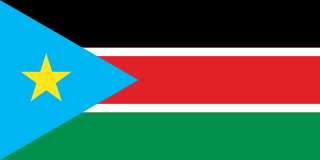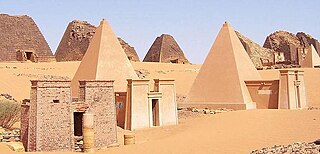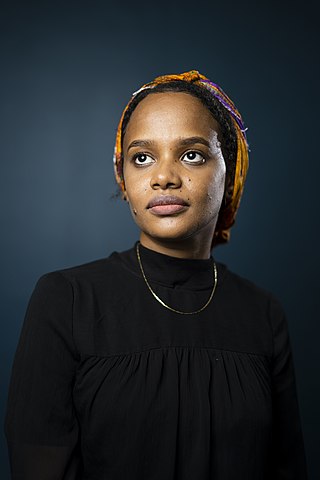Related Research Articles

Khartoum or Khartum is the capital of Sudan. With a population of 6,344,348, Khartoum's metropolitan area is the largest in Sudan.

The rich and varied music of Sudan has traditional, rural, northeastern African roots and also shows Arabic, Western or other African influences, especially on the popular urban music from the early 20th century onwards. Since the establishment of big cities like Khartoum as melting pots for people of diverse backgrounds, their cultural heritage and tastes have shaped numerous forms of modern popular music. In the globalized world of today, the creation and consumption of music through satellite TV or on the Internet is a driving force for cultural change in Sudan, popular with local audiences as well as with Sudanese living abroad.
Sudanese literature consists of both oral as well as written works of fiction and nonfiction that were created during the cultural history of today's Republic of the Sudan. This includes the territory of what was once Anglo-Egyptian Sudan, the independent country's history since 1956 as well as its changing geographical scope in the 21st century.
Osman Waqialla, was a 20th century Sudanese painter and calligrapher, noted for his creative use of Arabic letter forms in his artworks, thereby integrating African and Islamic cultural traditions into the contemporary art of Sudan. This use of Arabic calligraphy as a modern, non-religious graphic form places Waquialla within the Arabic art movement that became known as the Hurufiyya movement.
The Sudan Library is a section of the library of the University of Khartoum. It serves as the national library of Sudan, and is also a university research library.

The culture of South Sudan encompasses the religions, languages, ethnic groups, foods, and other traditions of peoples of the modern state of South Sudan, as well as of the inhabitants of the historical regions of southern Sudan.
The National Records Office of Sudan, located in Khartoum, serves as the National Archives of Sudan. It holds 20 million documents and 13,000 volumes about the history of Sudan since 1870.

The Khalifa House Museum is an ethnographic museum, located opposite the tomb of Muhammad Ahmad in the city of Omdurman in Sudan. Towards the end of the 19th century, it was the residence of the successor of the Mahdi, Khalifa Abdallahi ibn Muhammad and the headquarters of the administration of the Mahdi State. The House was converted into a museum in 1928 during the Anglo-Egyptian condominium.

Photography in Sudan refers to both historical as well as to contemporary photographs taken in the cultural history of today's Republic of the Sudan. This includes the former territory of present-day South Sudan, as well as what was once Anglo-Egyptian Sudan, and some of the oldest photographs from the 1860s, taken during the Turkish-Egyptian rule (Turkiyya). As in other countries, the growing importance of photography for mass media like newspapers, as well as for amateur photographers has led to a wider photographic documentation and use of photographs in Sudan during the 20th century and beyond. In the 21st century, photography in Sudan has undergone important changes, mainly due to digital photography and distribution through social media and the Internet.

The 2019–2022 Sudanese protests were street protests in Sudan which began in mid-September 2019, during Sudan's transition to democracy, about issues which included the nomination of a new Chief Justice and Attorney General, the killing of civilians by the Rapid Support Forces (RSF), the toxic effects of cyanide and mercury from gold mining in Northern state and South Kordofan, opposition to a state governor in el-Gadarif and to show trials of Sudanese Professionals Association (SPA) coordinators, and advocating the dismissal of previous-government officials in Red Sea, White Nile, and South Darfur. The protests follow the Sudanese Revolution's street protests and civil disobedience of the early September 2019 transfer of executive power to the country's Sovereignty Council, civilian prime minister Abdalla Hamdok, and his cabinet of ministers. Hamdok described the 39-month transition period as defined by the aims of the revolution.
Cinema of Sudan refers to both the history and present of the making or screening of films in cinemas or film festivals, as well as to the persons involved in this form of audiovisual culture of the Sudan and its history from the late nineteenth century onwards. It began with cinematography during the British colonial presence in 1897 and developed along with advances in film technology during the twentieth century.
Ala Kheir is a Sudanese photographer, cinematographer and mechanical engineer. He became known as one of the founders of the Sudanese Photographers Group in Khartoum in 2009 and through international exhibitions of his photographs, as well as for networking and training for photographers in Africa.
Rashid Mahdi was a Sudanese photographer, active in Atbara from the 1950s to the 1970s. French photographer Claude Iverné, founder of a large archive of photographs dedicated to this "Golden Age" of photography in Sudan, called Mahdi "certainly the most sophisticated and one of the major African photographers of the 20th century."

The visual arts of Sudan encompass the historical and contemporary production of objects made by the inhabitants of today's Republic of the Sudan and specific to their respective cultures. This encompasses objects from cultural traditions of the region in North-East Africa historically referred to as the Sudan, including the southern regions that became independent as South Sudan in 2011.

The architecture of Sudan mirrors the geographical, ethnic and cultural diversity of the country and its historical periods. The lifestyles and material culture expressed in human settlements, their architecture and economic activities have been shaped by different regional and environmental conditions. In its long documented history, Sudan has been a land of changing and diverse forms of human civilization with important influences from foreign cultures.

Soudan 2019, année zéro is a book about the Sudanese revolution, published in French in 2021. It contains descriptions, commentaries and photographs of the protestors' sit-in area during the weeks in May and June 2019 that led up to the Khartoum massacre. As additional visual documents, the book contains images by Sudanese documentary photographers, illustrating different stages and social backgrounds of the revolution up to the destruction of the sit-in by security forces on 3 June 2019.
Taghreed Elsanhouri is a British-Sudanese documentary filmmaker, film producer and author, based in London. She is mainly known for All about Darfur (2005), a film about the war in Darfur. For her 2012 documentary Our Beloved Sudan, she interviewed Sudanese politicians as well as a Sudanese citizen with parents from both the northern and southern parts of Sudan, presenting both political and individual stories before independence of South Sudan in 2011.

Amna Elhassan is a Sudanese visual artist and trained architect, who lives and works in Khartoum. Her artistic work is often focused on the perception of Sudanese women in public and private life, expressed in a variety of media, including printmaking and painting.
The College of Fine and Applied Art in Khartoum is the only public art school in Sudan. Its predecessor was founded by the British administration in 1945 as School of Design in the former Gordon Memorial College. In 1951, it was incorporated into the Khartoum Technical Institute that became the Sudan University of Science and Technology (SUST) in 1971, and the school was renamed College of Fine and Applied Art.
The Sudan Ethnographic Museum is a public museum in Khartoum, the capital of Sudan. Established in 1956 as a branch of the National Museum of Sudan, it is located at the corner of El Mek Nimr and al-Gamaa Avenue in downtown Khartoum. Until its closure in the early 2020s, the museum presented cultural objects representing the lifestyles and traditions of different regions and some of the many ethnic groups of Sudan. Similar to other museums in Khartoum, the Ethnographic Museum has been subject to looting and vandalism due to the ongoing war in Sudan since 15 April 2023. A project for complete renovation and digital inventories of the collection was started in 2022 by the Cultural Protection Fund (CPF) of the British Council and other international, as well as Sudanese organizations. It is accessible online through the platform "Safeguarding Sudan's Living Heritage."
References
- ↑ "Population, total - Sudan | Data". data.worldbank.org. Retrieved 2022-04-02.
- ↑ "Sudan". Ethnologue. Retrieved 2022-04-02.
- ↑ "About - Sudan Memory". www.sudanmemory.org. Retrieved 2022-04-03.
- ↑ "Conserving Sudanese cultural heritage". British Council. Retrieved 2022-04-03.
- ↑ "Sudan Memory: The project digitising a country's history". Middle East Eye. Retrieved 2023-02-25.
- ↑ "Sudan Memory: Conserving and Promoting Sudanese Cultural and Documentary Heritage". Culture in Crisis. Retrieved 2022-04-02.
- ↑ "Sudan Memory: Conserving and Promoting Sudanese Cultural and Documentary Heritage | Aliph Foundation - Protecting heritage to build peace". Aliph Foundation. Retrieved 2022-04-03.
- ↑ "SUDAAK - Sudan Memory". www.sudanmemory.org. Retrieved 2022-04-02.
- ↑ "Sudan Memory Team - Sudan Memory". www.sudanmemory.org. Retrieved 2022-04-02.
- ↑ "The Lyrical Revolution - Sudan Memory". www.sudanmemory.org. Retrieved 2022-04-02.
- ↑ "Topics - Sudan Memory". www.sudanmemory.org. Retrieved 2022-04-02.
- ↑ "Highlights - Sudan Memory". www.sudanmemory.org. Retrieved 2022-04-02.
- ↑ "Mahdia - Sudan Memory". www.sudanmemory.org. Retrieved 2022-04-02.
- ↑ "Sharhabil Ahmed - Sudan's King of Jazz - Sudan Memory". www.sudanmemory.org. Retrieved 2022-04-03.
- ↑ Honigman, David (2020-07-17). "Sharhabil Ahmed: The King of Sudanese Jazz — urgent and explosive" . Financial Times. Retrieved 2020-09-13.
- ↑ "Darfur Women's Museum: A Darfur Hero's Story - Sudan Memory". www.sudanmemory.org. Retrieved 2022-04-03.
- ↑ "Western Sudan Community Museums | Aliph Foundation - Protecting heritage to build peace". Aliph Foundation. Retrieved 2022-04-03.
- ↑ "Sudan Community Museums - Sudan Memory". www.sudanmemory.org. Retrieved 2022-04-02.
- ↑ "National Archive of South Sudan | Rift Valley Institute". riftvalley.net. Retrieved 2022-04-12.
- ↑ "Sudan Open Archive". www.sudanarchive.net. Retrieved 2022-04-02.
- ↑ Gotto, Francis. "Guides: Archives and Special Collections: Sudan Archive: Home". libguides.durham.ac.uk. Retrieved 2022-04-02.
- ↑ Elhassan, Dalia (May 2020). "The Sudanese Gaze: Visual Memory in Post-Independence Sudan". SUNU JOURNAL. Retrieved 2022-05-12.